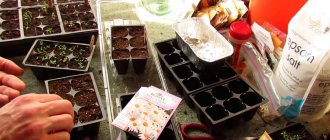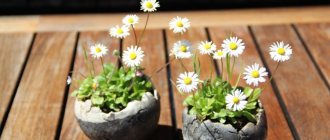Marigolds are one of the most popular flowers that every person has encountered. Its attractiveness and popularity is due to its lush and long flowering, and the flower heads have various rich shades from lemon yellow to red and fiery brown, attracting the eye from afar. In our article about marigolds, we will tell you about existing varieties, the features of growing these plants, and also answer questions about what else marigolds are useful for and how they can be used.
Rules for planting in the ground and recommendations
From planting seeds to transplanting plants into the ground, it takes about 6-8 weeks (about 2 months). Marigolds prefer soils with neutral or slightly acidic pH = 6.0-7.0. It is best to pre-enrich the soil with compost; this will also be a good solution for the drainage function. Several recommendations for transplanting seedlings into the ground:
- Transplantation dates: end of May/beginning of June;
- Feed young plants before flowering 2-3 times with complex fertilizer;
- When planting, the stem of each plant goes 2 cm deep into the soil;
- The distance between marigolds in flower beds when planting depends on their height and variety. Low-growing ones are planted at a distance of about 20 cm from each other, tall ones need more space, so a distance of 30-40 cm is maintained between plants.
Different variants
Petunia beds are usually arranged near the house. They are clearly visible from all sides and can have different shapes:
- oval;
- circle;
- rectangle;
- triangle;
- figured area.
To create such beautiful flower beds, you need to plant short flowers along the edges, and tall ones in the central part. First option: place the tallest plants (dahlias, gladioli, chrysanthemums) in the center, then medium-sized plants (tall marigolds and snapdragons), and low-growing purslane closer to the edges of the flowerbed.
Flower beds in which flowers are selected according to color look beautiful. For example, a group of white, blue and red plants. You can alternate different types of asters with several Chernobrivts.
If the flower bed is planted in the form of long strips, such a fence is called ridges. They are usually located along the walls of the house. The planting system is the same: in the background there is a row of tall plants, then a row of medium-sized petunias and at the end the shortest plants.
Any flower beds, ridges or lawns can be highlighted with a living flower border. For example, plant a path using low-growing marigolds. If you increase the width of the border to 4 m and plan to plant plants with different flowering times, you will get a constantly blooming mixed border. Low-growing marigolds combine well with other annual and perennial plants, as well as with ornamental shrubs.
Caring for marigolds
Marigolds are unpretentious garden pets, so to enjoy their flowering, you need to follow a few rules for caring for these beautiful plants:
- The place for planting should be well lit or slightly shaded;
- The optimal temperature for full development is considered to be from 20 to 24 degrees Celsius;
- Marigolds do not like drafts, so you need to provide a protected place, at least with other plants growing nearby in the group;
- Plants tolerate drought well, but with poor watering, flowering will slow down and there will be fewer buds;
- Regular feeding has a good effect on the flowering and appearance of marigolds. They need to be applied in stages: when the plants reach a height of 10-13 cm, then when the first buds form and at the beginning of flowering;
- It is better to reapply fertilizer no earlier than after 30 days;
- The soil around the marigolds needs to be loosened and weeded;
- To prolong flowering, faded shoots can and should be removed.
Golden placers
The most suitable flowers for filling a flower garden are annuals. Bright colors, unpretentiousness and long flowering are their distinctive features.
There are many options here: alyssum, petunia, salvia, drummond phlox, ageratum, snapdragon. But the palm undoubtedly belongs to marigolds. There is perhaps no other flower that so successfully combines excellent decorative qualities and unpretentiousness. Marigolds are not picky about soil, do not need frequent watering, and take root well when transplanted even in a flowering state. In open ground, both planting and caring for marigolds is simple. The only condition for their comfortable existence is the presence of light most of the day. In the shade there will be more greenery than flowers.
Marigolds are very diverse both in height and in the shape and size of flowers. The color palette of these plants is not very wide; they come in yellow, orange, red and brown. But inside it there is a huge variety of shades and color combinations. There are many hybrid forms that surpass their parents in flower size and decorativeness. Varieties with creamy and pure white flowers have been bred. Flowerbeds of these sunny and bright flowers will be appropriate in a garden decorated in any style of landscape design.
It will be useful to read:
Design of a flower bed with roses Rose is without a doubt one of the most beautiful flowers. Therefore, you can meet her in almost every garden. Here…
Practical benefits of marigolds
The main and main use of marigolds is decorative floriculture and landscape design. But this is not their only modern purpose! Here's where else marigolds are used:
- In cooking (as a seasoning, marigolds are used in the Caucasus to prepare an analogue of the spice saffron, which by analogy was called “Imereti saffron”);
- In the treatment of diseases (medicinal tea is brewed; Mexico is especially famous for this use of marigolds, where the leaves are used as a remedy for fever, cachexia, constipation, as a diuretic and diaphoretic; in large doses it is known to be used as an emetic);
- In pharmaceuticals (the root system of marigolds contains the antibiotic thiophene);
- In wedding and holiday ceremonies (in Thailand and India, marigolds are used to make flower garlands, decorations for holidays and weddings);
- As a national symbol (often mentioned in Ukraine, this flower is the hero of songs, poems and fairy tales).
Attention! There are several contraindications for consuming marigolds as food and medicine.
This:
- The occurrence of individual allergic reactions (swelling, redness, rash, etc.);
- Personal intolerance to the constituent parts of the plant;
- Pregnancy.
What plants should not be planted with?
Despite the fact that marigolds get along well with various plants in landscape design, there are still crops with which they should not be planted too close. Chernobryvtsy, along with a smell that repels pests, also release substances that can inhibit the development of certain crops: peas, radishes, beans. It is also believed that Chernobyvtsi have a negative effect on rose gardens.
Interesting facts about marigolds
Marigolds are plants with a rich history. They have been known for a long time and are quite well studied. These are among the most popular and used flowers among gardeners from many countries. Did you know that:
- In different countries, marigolds are called by several names. In Belarus these are “Aksamites”, in Ukraine - “Chernobrivets”, in Russia - marigolds or marigolds, in Great Britain - “marigolds” (Mary’s gold), and in Germany they are known as “Turkish carnations” or “student flowers”;
- The birthplace of flowers is America. In this area, from New Mexico and Arizona to Argentina, they grow wild;
- In the language of flowers, marigolds symbolize courage, strength and courage;
- The smell of marigold leaves is much stronger and more pronounced than the aroma emanating from the buds;
- Dried marigold flowers are the raw material for making a seasoning known in Russia and the Caucasus - it is called “Imereti saffron” (after the name of the Imereti Lowland). The spice is used to give dishes a golden and reddish hue, as well as a pleasant aroma;
- In Mexico, marigold foliage is used by local residents to treat fever and constipation;
- If you plant marigolds near cucumbers, you can thus increase the yield of the edible crop, since the aromatic plants attract natural pollinators - bees.
Imereti saffron
Main varieties
There are several varieties of marigolds, on the basis of which new varieties with large or small flowers, double or regular petals are constantly being developed. But they all have a brown, yellow, red or orange tint.
Attention: breeders have managed to develop unique marigolds - white in color.
Rejected marigolds (Tagetes patula)
This is a low-growing group of marigolds, which are also called French, small-flowered or spreading. Their bushes are unstable and often bend downwards. Their height varies from 15 cm to 60 cm. Their central shoot is erect, and the side shoots are deviated (hence the name of the group). The shoots branch heavily, so the bushes are usually wide.
The leaves of rejected marigolds are pinnate and small, with jagged edges and dark green in color. They come in pairs and alternating. The flowers of these varieties are single and collected in inflorescences. And the petals can be simple or double. Typically, these varieties have two to three colors, and monotonous colors are rare. Common colors are lemon and dark brown. Their flowering begins in June and continues until September. Popular rejected varieties are: Carmen, Bonanza Bolero, Bonanza Orange.
Tagetes erecta
Despite the fact that their homeland is Mexico, in people and literature they are usually called African. This group reaches a height of 50 cm to 1 m. They have a fibrous root system, shoots are straight and directed upward (hence the name erect). The leaves are unpaired, toothed and dark green. Their inflorescences are usually monochromatic, although there are also two-color ones, with a diameter of 5 to 12 cm. Petals can be either double or simple. They bloom from early July until mid-autumn. They are among the largest blackbirds, and their common varieties are: Antigua, Kilimanjaro, Vanilla.
Video about growing and caring for marigolds
How to grow marigolds correctly. Basic care rules for beautiful and lush flowering. Join the viewing!
Marigolds are quite unpretentious and fast-growing flowers. Simple care for them will only bring pleasure, and you can enjoy flowering almost immediately after planting the seedlings in the ground and until the cold weather. A combination of different varieties of marigolds in flower beds will be an excellent solution for a beautiful garden, and the rich beneficial properties will help maintain health and keep the harvest from pests in the garden. We wish you good luck growing these flowers!
Germination of seeds
To grow seedlings of these unpretentious flowers from seeds, you need to let the seeds germinate. The best time for this is from mid-March to early April. Take a flat dish and place a cloth soaked in water on the bottom.
Place the marigold seeds on it and, covering the dish with polyethylene, place it in a warm place. The first shoots will emerge from the seeds in three days. You only need to buy seeds in the first year. Later, you can collect seeds from faded plants. They retain germination perfectly for 3-4 years.
Brief description of the species
Marigolds, which have become familiar to us and grow in almost every flower bed, come from distant Central America. Other known names:
In the wild, flowering plants can be found over a wide area from the southwestern United States to Argentina.
Marigolds are quite popular, resistant to weather conditions, and unpretentious. However, not everyone likes their specific smell.
This is interesting! In the 16th century, these flowers were brought from America to Europe, from where they later spread over a large territory. In 1753, the Swedish naturalist Carl Linnaeus classified them as a member of the Asteraceae family and assigned them the Latin name tag?tes - in honor of the Etruscan deity Tages.
Marigolds are herbaceous, abundantly flowering plants that are cultivated as annuals. They form compact and spreading bushes with branched stems, having a height of 15 to 120 cm. They produce simple or double flowers of all shades of yellow, orange and reddish-brown.
Marigolds are a valuable, very easy to grow medicinal plant. The inflorescence has medicinal uses. The most valuable thing is fresh, straight from the garden. During drying, the plant loses many medicinal qualities, and the content of phytoncides decreases.











